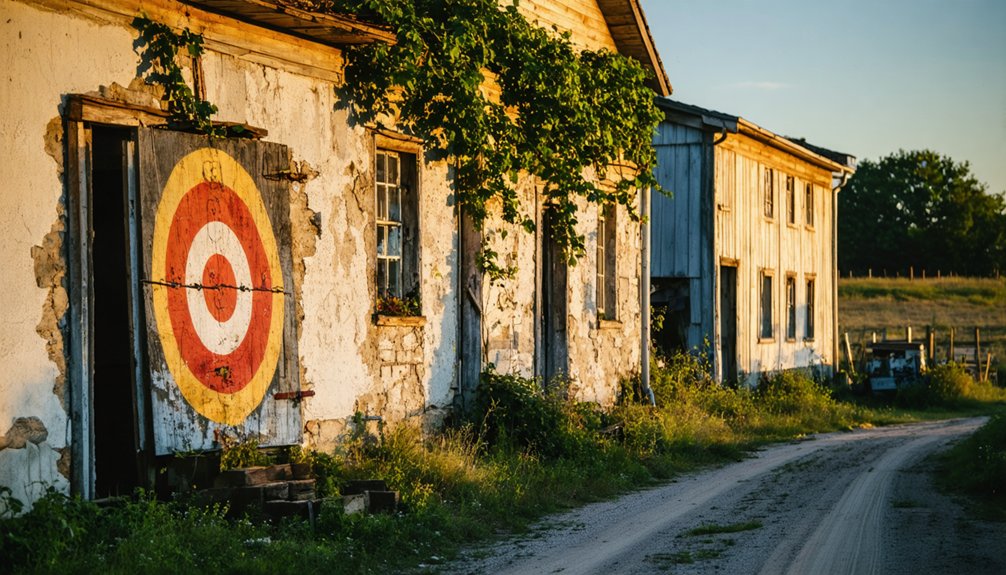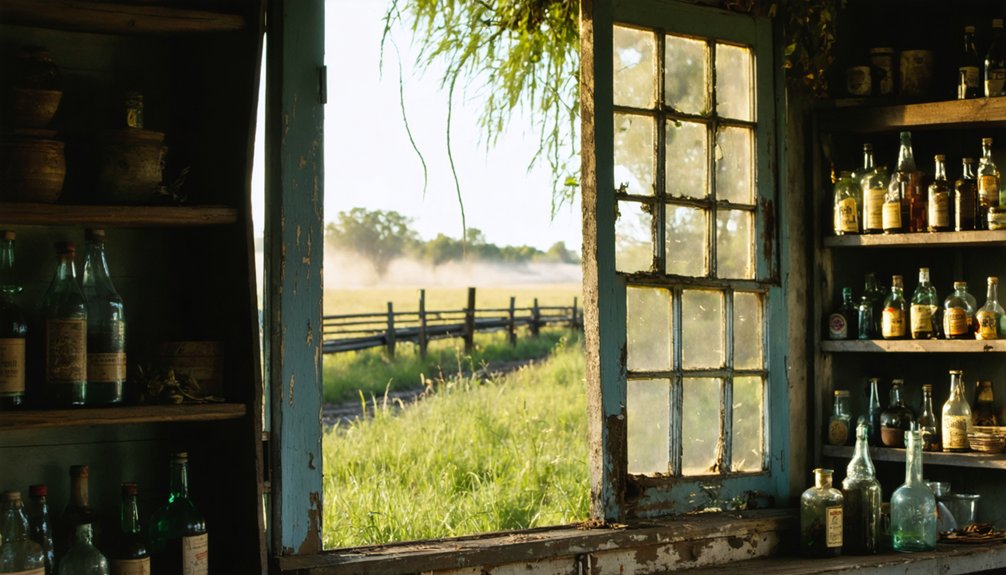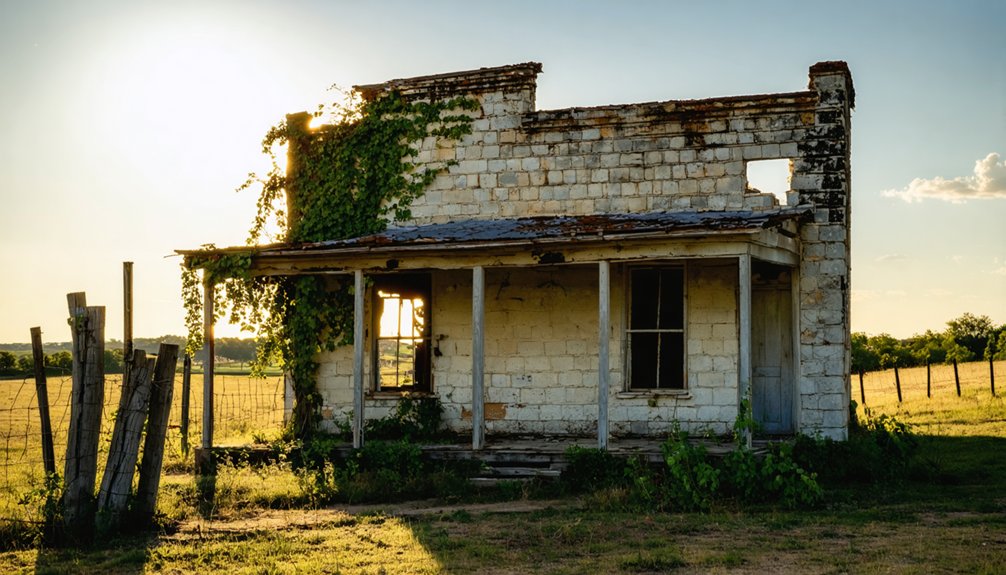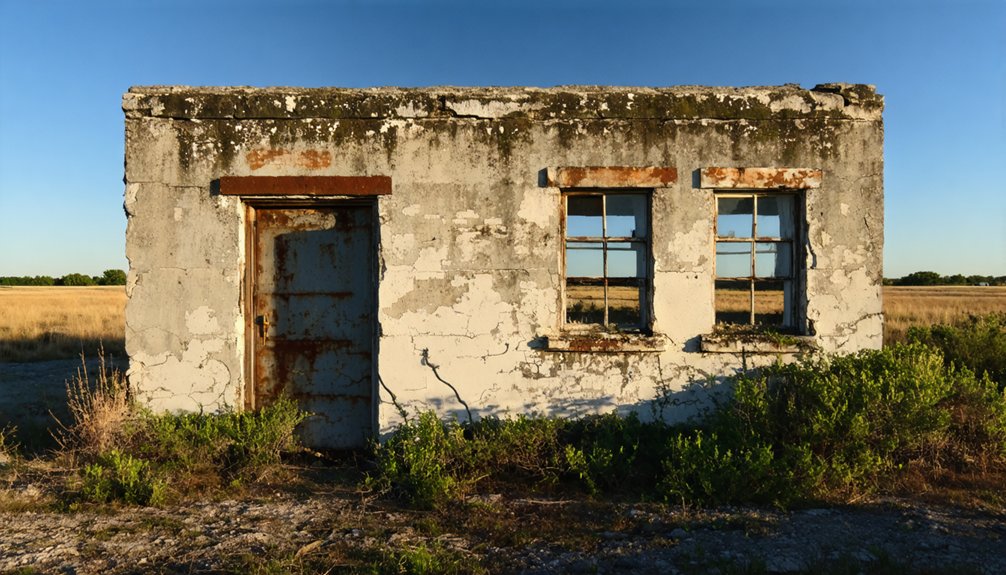You’ll find Grapetown’s ghost town remains along South Grape Creek in Texas Hill Country, where German settlers established a vibrant community in 1848. The town flourished as a stagecoach stop and farming hub, featuring Doebbler’s stone stables and a historic limestone schoolhouse. Despite opposing Confederate rule during the Civil War, the community persisted until economic shifts led to its decline. Today, preserved structures and cultural festivals keep Grapetown’s rich German heritage alive.
Key Takeaways
- Grapetown was established in 1848 by German immigrants and evolved into a thriving settlement before declining into ghost town status.
- The historic community center, originally built as a limestone schoolhouse in 1884, stands as one of the few remaining structures.
- Doebbler’s stone stables from 1860 represent the oldest surviving buildings in Grapetown, featuring authentic German Hill Country architecture.
- Economic hardships and isolation led to Grapetown’s eventual abandonment, though cultural events still occur at historic sites.
- The town’s location on the Fredericksburg-San Antonio road made it a significant stagecoach stop before its decline.
The German Settlement Origins Along South Grape Creek
While German immigrants flooded into Texas Hill Country during the mid-1800s, Grapetown’s story began specifically in 1848 when John Hemphill received the first land deed in the area.
By 1854, you’d have seen a surge of German families like the Doebblers, Hahnzogs, Schilds, and Pfisters arriving to claim their piece of Texas soil.
Despite initial settler conflicts over the Fisher-Miller Land Grant boundaries, these determined Germans established strong roots.
Through adversity and land disputes, German settlers persevered, laying down lasting foundations in their newfound Texas home.
The community included several skilled German workers who brought their expertise in carpentry and farming to help establish the settlement.
They’d overcome land disputes by purchasing properties like Friedrich Doebbler’s 160 acres along South Grape Creek in 1856.
The community’s resilience showed in their ability to organize quickly, building homes from local limestone and creating social structures that reflected their Lutheran faith and German traditions.
They’d transform this wild frontier into a thriving settlement that preserved their cultural heritage.
Like other communities in Gillespie County, their dedication to education led them to establish one of the area’s free public schools.
Early Farming and Transportation Hub
These German settlers quickly turned their frontier holdings into productive farmland and ranchland, setting the foundation for Grapetown’s agricultural economy.
You’ll find their farming techniques revolutionized the region, as they transformed the landscape into thriving corn and wheat fields that produced thousands of bushels by 1850.
Grapetown’s strategic location on the Fredericksburg-San Antonio road made it a essential transportation hub.
When Ferdinand Doebbler established his stagecoach stop in 1857, you could see freight wagons and cattle drives regularly passing through, connecting local ranchers to livestock markets.
The settlement’s position at the crossing of Immigrant Road and South Grape Creek helped farmers move their products efficiently, while Charles Schreiner of Kerrville became a primary buyer for the area’s cattle, establishing Grapetown as a important link in regional commerce.
The heart of the community’s social life centered around Doebblers Inn after its completion in 1862, serving as a gathering place for locals and travelers alike.
The town’s educational foundation was established when Louis Hartwig began teaching the first classes in 1859.
The Historic Limestone Schoolhouse Legacy
As German settlers prioritized education in their growing community, Ferdinand Doebbler opened Grapetown’s first school in his home around 1859, laying the groundwork for what would become an enduring educational legacy.
You’ll find that by 1884, the community had constructed a native limestone schoolhouse through donated labor and materials, showcasing their commitment to learning.
The one-room structure, with its distinctive bell tower and tin roof, served seven grades under a single teacher.
While schoolhouse artifacts like the original well pump and outhouses were eventually replaced with modern amenities, the building’s core remained steadfast.
The property became District #21 when it was officially designated as Lower South Grape Creek in 1889.
The school later became Grapetown Line School in 1905 before consolidating with Rocky Hill School District.
Even after its closure in the mid-1900s, you’ll see how the schoolhouse continues to unite the community as a cherished gathering place, now protected as a Recorded Texas Historic Landmark.
Civil War Division and the Nueces Massacre
Despite Texas joining the Confederacy in 1861, Gillespie County’s German settlers stood firmly against secession, voting 400 to 17 to remain in the Union.
Captain Duff’s Rangers ruthlessly enforced Confederate control through flogging and arrests of resisters.
As Unionist sentiments persisted, Confederate authorities imposed martial law by 1862, forcing loyalty oaths and monitoring local communities.
In a tragic turn of events, about 60 conscientious objectors, including Grapetown residents August Hoffman and Heinrich Rausch, fled toward Mexico to escape Confederate repression.
Confederate irregular James Duff’s forces ambushed them at the Nueces River, killing 34 men. Hoffman and Rausch survived by escaping into the hills.
The Civil War’s local impact culminated in a final clash near Fredericksburg in 1865.
Today, the Treue der Union Monument in Comfort stands as a rare tribute to these Texas Unionists, permanently flying the U.S. flag at half-mast.
Bundes Schützenfest and Cultural Heritage

When German immigrants settled in Gillespie County during the 1880s, they brought with them the cherished tradition of Bundes Schützenfest, a competitive shooting festival that would shape the region’s cultural identity for generations.
Grapetown hosted the first annual county-wide Schützenfest, establishing its significance in Texas Hill Country’s German heritage. These events weren’t just shooting competitions – they served as essential social gatherings that helped pioneers cope with frontier hardships while preserving their cultural traditions. The social gatherings provided much-needed respite from the challenges of pioneer life, just as they did for other German shooting clubs of the era.
The highlight was crowning the Schützenkönig (King of Marksmen), who received the honored Ehrenscheibe target disk. The tradition continues today as five teams compete annually for this prestigious title.
The coveted title of Schützenkönig brought prestige to German-Texan marksmen, marked by the ceremonial presentation of the Ehrenscheibe.
Though Texas once boasted over 200 shooting clubs, fewer than 20 remain active today. The Tivydale Shooting Club now carries forward this legacy of cultural preservation through family-oriented festivities and marksmanship competitions.
Surviving Architecture and Historic Structures
You’ll find several historic limestone buildings still standing in Grapetown, including Doebbler’s stone stables from 1860 and a red tin-roofed schoolhouse from the 1880s.
These durable stone structures replaced earlier wooden buildings during the town’s peak development period, reflecting the settlers’ commitment to permanent settlement in the harsh Texas climate.
The buildings served as essential community gathering places, with Doebbler’s Inn functioning as both a general store and hostelry, while the limestone schoolhouse educated local children through the seventh grade.
The Grape Town shooting club became a central location for social events where residents would gather for dances and community celebrations.
Limestone Buildings Still Standing
Among Grapetown’s most enduring landmarks, the limestone buildings stand as evidence to German settlers’ architectural prowess and resourcefulness.
You’ll find Doebbler’s stone stables from 1860, the oldest surviving structure, showcasing traditional German limestone preservation techniques and architectural significance.
The buildings feature thick stone walls, deep porches, and high-pitched metal roofs that adapt perfectly to the Texas Hill Country climate.
You’ll notice the pale white limestone, sourced from local quarries like Dietz, creates distinctive bright facades. The random placement of stones with mortared joints reflects authentic German Hill Country style.
While many structures remain on private land today, you can still spot the red tin-roofed limestone schoolhouse and several preserved ranch houses that maintain their historical integrity despite the passage of time.
Community Center’s Historic Role
Originally built as a schoolhouse in 1884, the limestone structure that serves as Grapetown’s community center stands as a symbol of local volunteerism and adaptive reuse.
You’ll find this one-room building was constructed entirely through community effort, with materials donated by surrounding farms and ranches.
After serving generations of students until 1949, the Grapetown Community Club purchased the building in 1950, transforming it into a vibrant hub for community engagement.
The center continues to honor its educational legacy while fostering local stewardship through regular social gatherings and events.
Now a Recorded Texas Historic Landmark, it’s accessible to visitors and maintains its role as a focal point for preserving Grapetown’s cultural heritage, though political and religious activities remain prohibited as per original land stipulations.
Railroad Impact and Economic Transformation

While the arrival of the Fredericksburg and Northern Railway in 1913 promised economic growth for Grapetown, its impact proved both transformative and challenging.
You’ll find evidence of remarkable railroad challenges in the construction of the “Big Hill” tunnel, where 250 men worked grueling 12-hour days for six months to blast through limestone. This 920-foot engineering marvel came at a steep cost, both human and financial.
Despite enabling vital transport of agricultural products and industrial supplies, economic limitations plagued the railway’s operations.
You can trace the line’s struggles through its slim profit margins and eventual reorganization by 1917. While you’d have seen improved shipping of heavy goods like bricks and tractors, the railroad’s benefits weren’t enough to prevent Grapetown’s eventual decline into ghost town status.
Community Life and Social Gatherings
You’ll find that Grapetown’s community life centered around its German cultural heritage, with residents regularly gathering for traditional shooting festivals and German-style celebrations at the Grapetown Shooting Club.
The local school building, constructed in 1884 from limestone, served as another essential hub where the community came together for various social functions and meetings.
After the school’s consolidation in 1949, the building was repurposed as a community center by the Grapetown Community Club, ensuring it continued as a cornerstone of local social life.
German Cultural Traditions
As German immigrants settled in Grapetown during the mid-1800s, they established a rich tapestry of cultural traditions that defined their community life.
You’d find their heritage proudly displayed through traditional festivals like the Gillespie County Bundes Schützenfest, where German cuisine, folk music, and marksmanship competitions brought the community together.
Language preservation remained a cornerstone of their identity, with German actively spoken in church services, social clubs, and storytelling sessions.
The Schuetzen Verein and other cultural societies played an essential role in maintaining these customs, organizing events where traditional songs, poetry, and homeland narratives flourished.
Through shared meals of sausages and sauerkraut, communal celebrations, and oral traditions, Grapetown’s settlers created a vibrant cultural legacy that strengthened their community bonds.
School Building Gatherings
Beyond the cultural celebrations and German traditions, the Grapetown schoolhouse emerged as the heart of community gatherings throughout its history.
School events took place both inside and outside the limestone building, with closing year plays performed on its spacious porch. You’d find students performing on a wooden platform across the river in earlier years, before moving to local venues like Weinheimer’s and Luckenbach halls.
Even after its closure in 1960, the schoolhouse continues to bring people together.
Today, you’ll find community celebrations ranging from weddings to reunions within its historic walls. A dedicated community club, formed by descendants of former students, meets monthly to play traditional games and share stories, keeping the schoolhouse’s legacy of social connection alive.
From Thriving Township to Ghost Town Status

While Grapetown once thrived as a bustling German settlement in the 1850s, its journey to ghost town status reflects the harsh realities many Texas frontier communities faced.
You’ll find local folklore centered around the town’s dramatic decline, from Civil War tensions that split the community to economic hardships that gradually emptied its streets.
The town’s fate was sealed by a perfect storm of setbacks: the railroad bypassed it, the Great Depression struck hard, and changing transportation routes left it isolated.
Today, ghost town legends surround the scattered remnants of what was once a vibrant community. The old limestone schoolhouse, Doebbler stables, and a few ranch houses are all that remain, standing as silent sentinels on private lands where a thriving township once stood.
Preserving Grapetown’s Hill Country Heritage
Though Grapetown exists today as a ghost town, you’ll find its German heritage preserved through standing structures like the historic Grapetown School, which serves as a symbol of the area’s rich cultural past.
You can still experience the town’s enduring German-Texan legacy through the efforts of preservation groups like Friends of Gillespie County Country Schools, which maintain these historic buildings and organize educational programs.
The community center continues to bring residents together, hosting events and gatherings that keep Grapetown’s traditional Hill Country spirit alive despite its diminished population.
Historic Buildings Still Standing
A remarkable collection of historic structures stands as proof to Grapetown’s rich Hill Country heritage.
You’ll find Doebbler’s stone stables from 1860, the oldest surviving structures in the area, alongside the meticulously maintained Rausch ranch house.
The historic architecture continues with the 1884 native limestone schoolhouse, which now serves as the Community Club’s meeting hall, and the 1887 teacher’s residence still standing nearby.
The Grapetown Dance Hall, established in 1887, remains a symbol of the area’s cultural significance, though it’s now a members-only facility.
While some historic sites rest on private land, you can still spot the cemetery and church near the original town site, offering glimpses into the community’s past.
These buildings, crafted from local limestone, showcase the ingenuity of early Texas settlers.
German Cultural Legacy Endures
Despite significant changes over the decades, Grapetown’s rich German heritage continues to thrive through its distinctive Texas German dialect, traditional festivals, and vibrant cultural practices.
You’ll find the Texas German dialect still echoing through local gatherings, passed down through generations as a unique cultural marker.
The area’s cultural festivals, particularly Schuetzenfest with its disciplined target shooting competitions, keep German traditions alive.
Local culinary traditions showcase authentic German flavors through beloved staples like bratwurst, schnitzel, and house-made sauerkraut.
The community’s biergartens and social clubs preserve traditional music and dance, while family recipes guarantee German cooking techniques endure.
Through these living connections to their ancestral homeland, Grapetown’s residents maintain their distinctive German-Texan identity in the heart of the Hill Country.
Community Center Maintains Traditions
The heart of Grapetown’s cultural preservation beats within its historic schoolhouse, transformed into a vibrant community center in 1950.
You’ll find this Recorded Texas Historic Landmark continuing its legacy of social cohesion through regular community events that celebrate the area’s rich heritage.
The building’s ongoing significance is evident through:
- Traditional gatherings of historic clubs like the Grapetown Leidertafel and Eintracht Schuetzen Verein
- Cultural programs featuring authentic Hill Country elements that connect generations
- Open houses that showcase the building’s preserved features, including the original 1884 construction and adjacent teacher’s residence
Through dedicated volunteer efforts, the schoolhouse remains a symbol of Grapetown’s enduring spirit, bridging past and present while fostering meaningful connections among residents and visitors alike.
Frequently Asked Questions
What Are the Current Population and Demographics of Grapetown Today?
You won’t find current statistics for Grapetown’s population, as it’s a ghost town with virtually no permanent residents. Demographic trends indicate fewer than a dozen people might live in the area.
Are There Any Ghost Stories or Local Legends Associated With Grapetown?
While you’ll find haunted history at nearby McDow Hole with Jenny Papworth’s ghost, Grapetown itself has limited documented local folklore beyond its connection to surrounding Texas ghost town legends.
Can Visitors Access the Historic Buildings, or Are They on Private Property?
You can’t access Grapetown’s historic buildings, as they’re all on private property. While you’ll spot the old schoolhouse and stone stables from public roads, you’ll need permission for closer views.
What Happened to the Original Families Who Settled in Grapetown?
You’ll find many settler legacy families dispersed during economic downturns, with some descendants staying nearby while others migrated away. Family migration increased during the 1930s recession as opportunities dwindled.
Are There Any Annual Events or Celebrations Still Held in Grapetown?
Ever wonder about old traditions living on? You’ll find regular community gatherings at Grapetown’s Schuetzenfest, where the shooting club meets from March to October, plus monthly Community Club meetings and annual festivals throughout the year.
References
- https://www.youtube.com/watch?v=QvkD3isDi8c
- https://en.wikipedia.org/wiki/Grapetown
- https://texashillcountry.com/hill-country-ghost-towns-explore/
- https://www.chron.com/news/slideshow/Texas-ghost-towns-72894.php
- https://www.ghosttowns.com/states/tx/grapetown.html
- https://www.tshaonline.org/handbook/entries/bankersmith-tx
- https://www.allacrosstexas.com/texas-ghost-town.php?city=Grapetown
- https://www.texasescapes.com/TexasHillCountryTowns/GrapetownTexas/Grapetown-Schoolhouse-Texas.htm
- https://www.texasescapes.com/TexasHillCountryTowns/Grapetown-Texas.htm
- https://austinpbs.org/paintedchurches/history_germans



